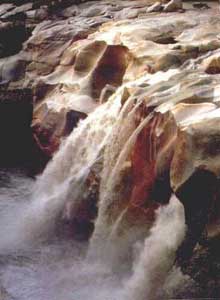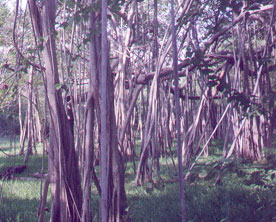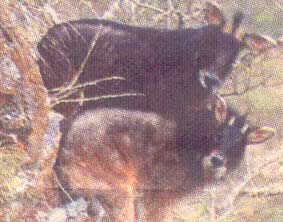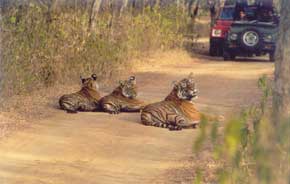Adventure
 'I believe any trip in search of wildlife can be coupled with physical activity and elements of cultural diversity to form a thrilling opportunity ' 'I believe any trip in search of wildlife can be coupled with physical activity and elements of cultural diversity to form a thrilling opportunity '
John H.Eickert
High in a valley, deep in the western Garhwal region of the Indian Himal is the meeting place of heaven and earth, here Gangotri glacier gives birth to the holy Ganga. It is said, a third of a million pilgrims
are drawn to this place, named Gaumukh (cow’s mouth) each year. It took three days for me to stand where I could see the river flowing out from under the Gangotri glacier. I had heard about pilgrims who would immerse themselves at this place believing bathing
here would wash away their sins. I watched a number of pilgrims perform this ritual. I was amazed at the sight. The swiftly flowing river, with ice chunks bobbing along, had to be cold. I decided to join in the ritual. I asked a number of pilgrims if it would
be proper for a non-Hindu to immerse himself here. I was encouraged to participate. Only time can tell if my sins were washed away, all the air in my lungs certainly was!
 The trail to Gaumukh begins where the road ends, at Gangotri. The centerpiece for Gangotri is the Temple of the Goddess Ganga and the beginning of the 18-kilometer three-day journey. Be sure and stop for
a blessing and an apple at the kuti of Swami Sundernanda along the path leaving Gangotri. The first day should take you to Chirbhasa and is an easy walk through deodar trees. Chirbhasa is where you will see the last trees on the journey, a small stand of ancient
juniper, and some silver birch. The second day winds through open meadow to near Bhujbasa. The third day involves difficult trekking to Gaumukh. There have been numerous landslides and progress can be difficult. The trail to Gaumukh begins where the road ends, at Gangotri. The centerpiece for Gangotri is the Temple of the Goddess Ganga and the beginning of the 18-kilometer three-day journey. Be sure and stop for
a blessing and an apple at the kuti of Swami Sundernanda along the path leaving Gangotri. The first day should take you to Chirbhasa and is an easy walk through deodar trees. Chirbhasa is where you will see the last trees on the journey, a small stand of ancient
juniper, and some silver birch. The second day winds through open meadow to near Bhujbasa. The third day involves difficult trekking to Gaumukh. There have been numerous landslides and progress can be difficult.
If you are very determined, there is more to see in this valley. Above Gaumukh, after a very, very difficult day are the Tapovan meadows. Tapovan is a wonderful place with tremendous mountain vistas. It is possible to see the mountains Kirti Bamak, Kedarnath,
Shivling, Meru, and the Bhagirathi ‘Sisters’ from different points. Tapovan makes a wonderful base camp for exploring to Shivling base camp or the high meadows near Nandavan where blue sheep are often seen. There are two choices for return; back down the path
of ascent or over the glaciers to Vasuki Tal and the temple at Kedarnath. Keep in mind the way to Kedarnath will be as tedious as from Gaumukh to Tapovan. There have been numerous recent landslides, which have destroyed older traditional routes.
In all, the pilgrimage to Gaumukh and trek to Tapovan are richly rewarding. It is also very accessible. With this accessibility and large number of pilgrims comes an overabundance of refuse. Pursue other trekking opportunities if you are searching for solitude
in a pristine place. I recently read the Indian Mountaineering Association believes this area to be the most polluted in all the Himal. Please do not add to the refuse. Carry out more than you carry in! Take the time and take your time. Enjoy!
Visit
http://www.numbum.net or call NumBum Adventurers at 406-777-2228
|
Answers To Quiz Of The Month
Last month no one has given all right answers, but riyas4you@rediffmail.com has given 9 right answers
Here are right answers to Threatened fauna of India
| 1.In terms of the number of threatened mammals, India ranks………. |
|
| 2.A species is declared extinct if there are no records for …………….years when scientists have carried out repeated searches in all possible habitats.
|
|
25 years |
50 years |
100 years
|
|
| 3.The main cause of extinction of this magnificent animal was destructionof habitat and use for sports.
|
|
Asiatic cheetah |
the pink headed duck |
swamp deer
|
|
| 4.The pink headed duck ………….. |
|
has gone extinct |
lays perfectly spherical eggs |
Both the above statements are correct
|
|
| 5.Asiatic lions are confined to just one area, the Gir forest in Gujarat. A major disaster/disease within the park could wipe out the entire population at a stroke. Therefore an alternative
home for the lions has been identified at |
|
Kanha National Park
|
Kuno Palpo sanctuary in Madhya Pradesh |
Tadoba national Park in Maharashtra
|
|
| 6.This endangered tree dwelling animal is found in Central and Eastern Himalayas from Nepal to Arunachal Pradesh |
|
Himalayan Brown Bear |
Lion tailed Macaque |
Red Panda
|
|
| 7.This animal, in the crtically endangered list, is important for its gene pool from which domesticated stocks have been derived.
|
|
Wild Yak |
Asian elephant |
Indian Wild Ass
|
|
| 8.After cheetah, it is said to be the fastest animal which can reach to a speed of 100-104 km per hour.
|
|
Barasingha |
Black Buck |
Leopard
|
|
| 9.Most threatened among Indian serpents, this one is considered `endangered` |
|
Reticulated Python |
Saw scaled viper |
Russel`s viper
|
|
| 10."There is nothing in nature to prove that it cares for our human species than for daffodils. We may vanish as quickly and as radically as thousands of other breeds before us." Where are
these words written? |
|
`Only the Paranoid Survive` by Andrew Grove |
`Heaven, earth and I ` by Vivek Menon |
`Vanishing Species` by Romain Grey
|
|
Please try our quiz for the current month on
elephant poaching
|
Did You Know ?
Banyan
Botanical Name: Ficus bengalensis Sanskrit name: Nyagrodha, Kalpavriksha
English Name: Banyan Hindi name: Vad
The banyan tree is well known all over India. The tree has what is known as the “aerial roots” its branches drop to the ground, take roots again, and send out more twisting and trailing branches, thus extending the growth of the
tree indefinitely. The Banyan is sacred to Hindus and Buddhists.
The name Banyan tree in English seems to have been given by Europeans in the Persian Gulf to a particular tree of this species under which Banias or members of the Indian merchant class used to congregate for worship and business.
Nyagrodha symbolizes Shiva and is, therefore, held sacred. Worshiped on Hindu Festival “Vad-Savitri Day” the tree is also the symbol of Lord Bramha.
 Nyagrodha tree in Hindu mythology is called Kalpavriksha or the wish fulfilling tree, a tree that gives to the worshiper, food and drink, clothes and ornaments, gift of children and even beautiful maidens. The anthromorphic
worship of the tree is represented in a Buddhist sculpture from Besnagar. Nyagrodha tree in Hindu mythology is called Kalpavriksha or the wish fulfilling tree, a tree that gives to the worshiper, food and drink, clothes and ornaments, gift of children and even beautiful maidens. The anthromorphic
worship of the tree is represented in a Buddhist sculpture from Besnagar.
The Pradhan tribes worship the tree because of the following reason. When Jalrandha, the guru of the Pradhan tribe died, his body was buried by his son under Palas (Flame of the forest) tree. The sons used to daily light a fire
on the grave to keep away the animals from desecrating the grave. One day they found a Nyagrodha tree growing out of the grave. That night the eldest son of the guru had a dream in which his father asked him to look after the tree as it had grown out of their
father’s bones and brains. Pradhans consider the hanging roots of the tree as the matted, long hair of the guru.
In Vishnu Purana, the tree is compared to Vishnu ; “As the wide spreading Nyagrodha tree is compressed in a small seed, so at the time of dissolution, the whole universe is compressed in thee as its germ. As the Nyagrodha germinates from the seed and becomes
first a shoot and then rises into loftiness, so the created world proceeds from thee and expands into magnitude.”
It occurs throughout the forest tracts of India, from the sub-himalayan region to the deciduous forests of Deccan and south India. It yields fodder, medicine, rope and timber and is useful in afforestation of dry areas.
Various parts of Banyan have medicinal properties. The latex is applied externally to bruises, and in rheumatism, lumbago and toothache. The leaves are applied as a poultice to abscesses. The bark is astringent, used in dysentery,
diarrhoea and diabetes.
_______________________________________________________________________
Importance of Indigenous plants in Indian Mythology and folklore—Compiled by Ms. Priti Sawant
Photograph of banyan roots by Susan Sharma
|
Endangered
(With inputs from Yasser Arafat)
Naemorhedus (=Capricornis) sumatraensis
Family: Bovidae
Group: Mammals
Status: Endangered
Serows (local- Sarauh) are the most generalized representatives of the bovid subfamily of goat antelopes called Caprinae, all of which probably evolved from a serow-like ancestor.
The mainland or Asiatic serow (Nemorhaedus sumatraensis) ranges from the Himalayas of Nepal, north to Gansu and Anhui in China, and south to the Malay Peninsula and Sumatra. Island species of serows are the Japanese serow (Nemorhaedus crispus) on Honshu, Shikoku
Island and Kyushu (Japan), and the Taiwanese serow (Nemorhaedus swinhoei) in Taiwan.
 Goat-like, the serow stands about 3.5 feet at the shoulder with a stocky body, thick neck, large head and ears, and short limbs. Its horns are stout and conical, pointed backwards, and present in both sexes. Serow are generally colored
black or reddish chestnut with white on their limbs, and they inhabit forests and wooded gorges. Usually, serow are solitary, and can be found from 6,000 feet to 10,000 feet in the Himalayan ranges in in Uttaranchal. About 50 numbers are known to exist in
Bhimtal, Uttaranchal. Goat-like, the serow stands about 3.5 feet at the shoulder with a stocky body, thick neck, large head and ears, and short limbs. Its horns are stout and conical, pointed backwards, and present in both sexes. Serow are generally colored
black or reddish chestnut with white on their limbs, and they inhabit forests and wooded gorges. Usually, serow are solitary, and can be found from 6,000 feet to 10,000 feet in the Himalayan ranges in in Uttaranchal. About 50 numbers are known to exist in
Bhimtal, Uttaranchal.
Habitat
Where serows and their close relatives, ghorals, share habitat, serows stay mainly in dense brush above timber line. Ghorals inhabit more precipitous and barren slopes. Life span in the wild is unknown; serows live over 10 years in zoos.
Serows, like all Bovidae, are specialized herbivores called ruminants.
In the wild: Serows are predominantly browsers with selective food habits. They eat herbs, leaves of trees or shrubs, shoots, twigs and grasses.
Reproduction
Mating takes place in fall or winter. After a gestation period of 200 to 230 days, a single kid weighing about 8 pounds (3.5 kg) is born during the months of May to September. The kid will reach full size and leave the mother’s territory at 12 months and become
sexually mature by 3 years.
Life Cycle
Serows, especially males, are usually solitary but sometimes are found in pairs or family groups of up to seven. Both sexes mark territories by rubbing onto rocks and branches a secretion from their pre -orbital glands. The territory of a solitary individual
may be only three acres (1.2 ha), while that of a family group may be up to 54 acres (22 ha).
Although they are less agile and move less rapidly than ghorals, serows are sure-footed, clambering easily along well-defined trails on mountain slopes. They feed at dawn and dusk. During the heat of the day, they take shelter in favorite
resting places among rocks, in caves, under overhanging rocks or cliffs, or in dense underbrush, hidden from predators such as bears, tigers and wolves. Their smell, vision and hearing are acute.
Fascinating Facts
Serows are the most primitive living Caprinae. Their fossils appear in the late Pliocene of 7 to 2 million years ago!
Serows can be aggressive and will attempt to fight off predators, even Asian black bears, with their dagger-like horns!
Serows will swim between the small islands near the Malay Peninsula!
Once numbering as few as 2,000 to 3,000, the Japanese Government in 1955 designated the serow a "special national monument." This designation ended a long period of over hunting. Japanese serows in the wild number about 100,000 today, so are no longer considered
endangered. However, all other serow species are vulnerable or endangered due to loss of their wild habitat through logging and conversion into farmlands and plantations.
(Photograph of Serow with her eight month old calf in Bhimtal jungle-by Yasser Arafat)
|
Members Speak
Bandipur National Park, Karnataka
" Is opening a national park to the public for trekking purpose is right or wrong? how you r going to identify good and bad people. no doubt that each and everyone must experience the wilderness. but for few penny u r not suppose to allow
tom,.dick and harry in a temple."
-Vinod
" There is nothing wrong with allowing people to look around and appreciate what others have worked so hard to conserve. Yes, there might be a problem with some people who might try to spoil the place
but that is something that can be controlled.
If you are conserving something beautiful for future generations, let them have a look at it and appreciate and understand it right now. Before they grow up not knowing what it is that people like you are fighting for today..."
-Jenny
" Why should we be allowed to wander around an animals natural habitat at will just because we want to or can??"
-Iain..
"If there was a choice, I would have agreed with you But there isn't.Today most of the space on earth, except maybe the Amazon has been taken over by human beings. The only way they can be convinced to not destroy what is still left of the natural habitat of
these animals is to 'show' them the conserved places to create an appreciation of it. People will never appreciate what they cannot see. IMO I certainly do not agree with the 'wander at will' part. I would certainly hope for a little bit of supervision to
be safe(knowing us human beings!)
-Jenny
"To say that most of the space has been taken up on Earth is totally inaccurate. Australia is a massive Country but less than the population of Greater London in England live there.Same again in New Zealand,same again in the U. and in Russia.Vast tracts of
land are uninhabitated. .........
- Iain
"Interesting topic of discussion. Especially since we were one of the first groups that did a trial run of some of these trails, proposed within Bandipur. And I was very impressed with the professionalism,
with which the dept is approaching the entire exercise.
While I am as ardent a conservationist as any of you, my view on the traditional theory of closing off wildlife areas, strongly differs. I truly believe that letting in nature lovers into our wild areas as
well as encouraging professionally run eco development projects, can contribute a lot to conservation in the long run.
Lets be pragmatic here. As long as our wild areas remain un-exposed to the people who are supposed to raise their voices to save them, and as long as they remain cost centres, without any self sustaining
revenue generation mechanism, success will always elude us.
My questions are :
1] Has closing off wild areas ever stopped the bad guys from entering them? NO. It only prevents the good guys. It is by now well understood that wildlife sanctuaries that do not permit even jeep
safaris and are totally cut off, have the highest incidents of poaching and other nefarious activities such as Ganja Cultivation, going on at will, because no knows what is happening in there.
2] What is wrong with properly sensitized, controlled number of groups sharing the joys of the forest? Trekkers who will trudge 15-20 Kms through the forest are not picnickers. They are usually sensitive about silence, littering
etc. In fact, our group & our guards picked up even the faint traces of plastic we saw along the way.
3] India is a poor country, with tremendous pressures on budgets and focus areas. For how long are we going to depend on foreign aid to save our wildlife, when they are actually am immense treasure, and
could be harnessed to save themselves?
While I understand that all of us are very concerned about throwing open the gates to hordes of people, and are keen to immediately rise in arms against such a move, I suggest that we also take a step back
and look at such things from another angle. Whether a middle path is possible, and whether the gains may actually outweigh the losses, for the very wildlife we are trying to protect. If we do that without
prejudice, we may actually come up with some different thoughts?
-Sandeep
"If animals are not allowed to enter our habitat y r we allowed to enter theirs?"
-ARoxruler
|
News and Views
News………
 The tiger contest is over and the winners are, The tiger contest is over and the winners are,
First Prize
Sandy Crooms, 3939 Ross Rd. USA email:
sandyandy1792002@yahoo.com
Second prize
Sherry 600 Church United States Michigan Hudson email:
amberlybowman82@hotmail.com
You can read the winning entries along with the audio visual by
clicking here.
We thank our judge Shekhar Dattatri - well known film maker who produced " Silent Valley-an Indian Rain forest" , "Nagarhole- Tales from an Indian Jungle" and " The Ridley's Last Stand" among others. Shekhar has also, at our request, sent
a short comment on the audio visual .
Shekar Dattatri
Wildlife filmmaker
Plot No.40, Door No.11
3rd East Street, Thiruvanmiyur
Chennai 600 041
Tel: + 91-44-2441 5744 or 2491 4802
Fax: + 91-44-2491 0910 or 2491 8747
Email: dattatri@vsnl.com
December 24, 2003
Comments on the Tiger Caption Contest:
"Humans are often anthropomorphic when judging the actions of animals – ie. we have a tendency to attribute human emotions and motives to animals. This can be misleading when we want to really understand animal behaviour.
The tigers in the movie clip are very obviously a mother and her two large cubs. Rather than doing a "rasta-roko” and trying to stop humans from using the road, or protesting the presence of people in the forest, the tigers are demonstrating
their trust in humans. They are supremely relaxed, and indifferent to the presence of the jeeps and the noisy camera-clicking tourists. They love the dirt road in the forest as it is even and soft, unlike the substrate in the forest where there is leaf litter,
stones, thorns and other pokey things! They seem content, and if at all they are communicating anything, it’s the feeling that all’s well with their world at the moment. "
Thank you to all the participants of the contest!
Indian reptiles
To those of us who have been wishing for more info on Indian snakes on the internet, here is good news. Some very rare and beautiful photographs by Harsha J are uploaded on the site
http://www.indianreptiles.com/. Do have a look.
Online chat
Our monthly online chat on "mangroves of India" could not take place this month as our expert moderator was unavailable. However Mr. Vivek Kulkarni, who has been in the forefront of protecting Mumbai's mangroves, will be available online between
7.30 PM and 8.30 PM on 18th January 2004. So please log in to the chat room and let us have a lively discussion.
After the black out of yahoo groups in India is over, our IndianWildlifeClub yahoo group is active once again. Interesting excerpts from a current topic of discussion can be
read here.
And views……..
Why Protect Biodiversity?
Good ecological and economic practices are two sides of one coin. The globe's food and water securities depends on the protection and wise use of biodiversity. Protecting water sources and soils directly improves the quality of human life.
India is the world's sixth richest nation on the biodiversity scale.
India has been blessed with unimaginable natural wealth - from the frozen frontiers of the Himalaya, rain forests in the Northeast, deserts and grasslands of Kutchh, Saurashtra and Rajasthan, the incredible forests of Satpuras, Western and Eastern Ghats. Equally
impressive are our inland wetlands and brackish water lakes, the coral reefs of the Andaman and Nicobar Islands and Lakshadweep. India is a virtual treasure trove of diverse habitats and landscapes.
Such diversity of habitats not only supports wildlife but also rich natural resources. These forests act as water catchments that help to recharge ground water, support livelihood of millions, act as carbon sinks, provide us with fresh air.
The contribution of these forests is invaluable.
The future of food and fresh water security lies in wise use of these resources.
( Courtesy BNHS Green Governance Programme)
|
Tips On Beauty Without Cruelty
|
 Deepika Vohra served as the head of the Department of Beauty Culture at the International Polytechnic for Women at New Delhi. She also ran a beauty clinic at Delhi's Vasant Kunj for some time from where she relocated to New
York for five years. Exposure to the world capital of beauty and cosmetics gave her an opportunity to compare the Indian beauty industry with the razzle dazzle of the New World. Reading and researching beauty culture has always been a hobby with her. The tips
for beauty given below were selected from her repertoire of nature based recipes which are time tested to deliver. Deepika Vohra served as the head of the Department of Beauty Culture at the International Polytechnic for Women at New Delhi. She also ran a beauty clinic at Delhi's Vasant Kunj for some time from where she relocated to New
York for five years. Exposure to the world capital of beauty and cosmetics gave her an opportunity to compare the Indian beauty industry with the razzle dazzle of the New World. Reading and researching beauty culture has always been a hobby with her. The tips
for beauty given below were selected from her repertoire of nature based recipes which are time tested to deliver.
|
|
How do you recognize your skin type?
NORMAL SKIN is finely textured with no visible pores, spots, or blemishes, soft and velvety to the touch, and unwrinkled. Normal skin has to be treasured and preserved, as it is liable to change,
if neglected.
OILY SKIN is caused by overactive sebaceous glands that give rise to large open pores. Larger pores, in turn, lead to blackheads, blemishes and acne. The appearance of blackheads and blemishes
is due to clogged oil and dirt in the pores which is not removed instantly by cleansing. Oily skin begins to have an oily shine within a few minutes after wash or make-up. This makes it difficult to hold make-up. However, oily skin has an advantage of ageing
very slowly, but deep cleansing must be thorough.
DRY SKIN is a sensitive skin type which comes in blotches, tends to peel off easily and feels tight after a wash. Lack of moisture results in dry skin and this skin type is more prominent around
the eyes, mouth, lips, sides of mouth, and forehead. Cleansing, toning, moisturizing form an integral routine of this type of skin. Dry skin is highly susceptible to diet, extremes in weather and harsh perfumed skin care products. Dry skin also has another
disadvantage. Wrinkles appear faster giving you a prematurely aged look. A generous application of moisturizer will produce a skin which would be on par with the 'enviable' peaches and cream complexion.
COMBINATION SKIN as the word 'combination' suggests it is mix of two different skin types on one face. More often this skin type is the result of a badly cleansed and neglected skin. It is easily
recognizable as it is oily down the T panel, that is the forehead, nose, chin. The skin gets this oily look down the T panel while the rest of the face appear and feel dry. Combination skin needs scrupulous cleansing. It is a good idea to use a face mask for
oily skin down the T panel and a mask for dry skin for the rest of the face. This method of treating the combination skin works ideally to give a perfect, balanced effect.
SENSITIVE SKIN this type of skin is extremely delicate and vulnerable. It is easily susceptible to freckles, itchy spots and blotches. Dermatitis and allergies caused by chemical cosmetics are
common problems of a sensitive skin. It is best to discontinue the usage of strong and harsh skin care products as well as perfumed creams and moisturizers
|
|
|
Face Mask
Masks are excellent beauty revivers and they provide the skin with instant rejuvenation. They nourish, rejuvenate and stimulate, refine, cleanse and peel off the outer skin layer, soothe and calm inflammation,
clear acne, loosen blackheads, act as an anti-wrinkle treatment and natural face-lift.While selecting a mask carefully select the mask best suited for your skin type. Masks must always be used on a clean skin and should be evenly applied. Mask application
must be avoided around the eyes and mouth. Once you know your skin type and its limitations, you can decide on a face mask made from a variety of fruits, flowers, vegetables and dairy products.
CARROT MASK
Carrots contain plenty of Vitamin A and are essential for sensitive skin
. Ingredients:
2 carrot
3 teaspoon honey
Method
Grate carrot. Extract the juice and stir in honey. Pat on skin. Leave on for 10 to 15 minutes. Rinse off.
POTATO MASK – (ideal mask for dry skin)
Ingredients
1 tablespoon raw grated potato
2 tablespoon curd
Method
Add curds to well grated potato and mix well. Apply on face and let it dry for 15 minutes before washing off.
OAT MEAL MASKS
Oat meal mask has softening as well as whitening properties. They are excellent exfoliating masks.
SIMPLE OAT MEAL MASK
Ingredients
12 tablespoon oatmeal a little milk water
Method
Soak oatmeal in milk and water for 15 minutes. Apply as a mask.
TOMATO MASK FOR OILY SKIN
Ingredients
1 tomato rind of 2 lemon dash of lemon juice
Method
Mash tomato and mix with very finely grated rind and add a dash of lemon juice. Put on face and rinse off after 10 minutes with warm water.
COOLING MASK
Ingredients
1 tablespoon milk powder
2 tablespoon oatmeal
2 tablespoon wheat germ
1 teaspoon sandal wood powder
1 teaspoon barley powder
2 teaspoon fenugreek powder
1 teaspoon kaolin
Method
Soak oatmeal in water for 10 minutes and combine all ingredients. Use just enough water to make a paste and apply. Leave it on for 15 minutes before washing off.
|
|
|